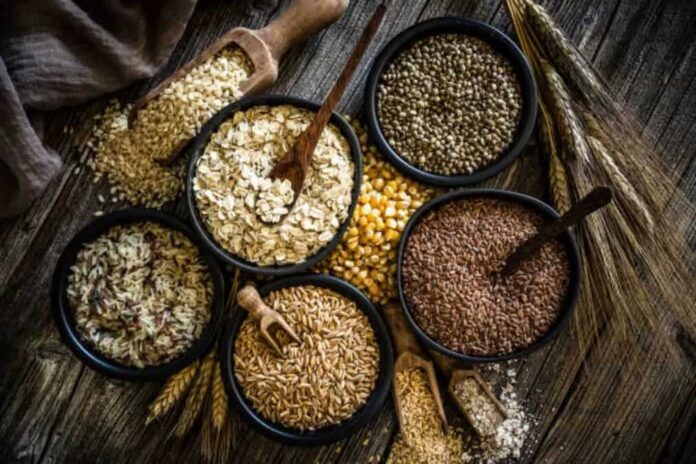They can improve general health, ease the discomfort of the digestive system, and lessen the symptoms of gluten-related illnesses. By using gluten-free grains, dietary options can be expanded and nutrient-dense dishes can still be enjoyed by those with special dietary needs.
Before making major dietary changes, it’s important to speak with a healthcare provider to make sure your specific needs are satisfied.
The following is a flowing list of some great options for gluten-free grains:
1. Rice:
A staple food for people with celiac disease, gluten sensitivity, or following a gluten-free diet, rice is a versatile and extensively consumed gluten-free grain. Because it is naturally gluten-free , it can be used in a variety of recipes, including sweets and main courses. Essential elements found in rice, such as vitamins, minerals, and carbs, support the body’s ability to produce energy and maintain general health.
People can choose from a variety of rice varieties, including brown rice, basmati, and jasmine, to fit their tastes.Rice flour can be used in various dishes like rice flat bread, rice cakes etc. Rice continues to be an essential and easily available part of a gluten-free diet, whether it is consumed as a side dish, as part of a main meal, or in the form of gluten-free flour for baking.
2. Corn:
A grain that is both naturally gluten-free and adaptable, maize is a great substitute for people who have gluten sensitivities. In gluten-free cuisine, corn-based ingredients like cornmeal, corn flour, and cornflour are essential for dishes like breads, muffins, fritters and more. These products are used as stand-ins in a variety of recipes, enabling people to indulge in a wide variety of foods without sacrificing their dietary requirements.
In addition to being gluten-free, maize is a great source of fibre, vitamins, and minerals. Due to its accessibility and extensive availability, it is a good option for people who want to eat a gluten-free diet but still enjoy satisfying and nourishing meals.
3. Millet:
Millet, a flexible grain that is free of gluten, has become more well-known for its nutritious qualities and culinary versatility. Millet grains include finger millet (ragi), pearl millet, and foxtail millet. Because it’s high in minerals and fibre, foxtail millet is frequently used in porridge or as a rice alternative. A mainstay of many Indian and African cuisines, pearl millet is renowned for its ability to withstand dry conditions.
Because of its high calcium content, finger millet, also known as ragi, is used in a variety of recipes, including rotis and porridge. For those looking for a nutrient-dense, gluten-free grain option, millet’s many kinds provide plenty of options.
4. Buckwheat:
Contrary to its name, buckwheat is gluten-free and offers a healthy substitute for people who have celiac disease or gluten intolerance. Brimming with vital elements such as fibre, protein, and many vitamins, buckwheat provides a comprehensive complement to a gluten-free diet. The antioxidants included in it help regulate blood sugar, strengthen heart health, and aid with digestion. It is a valuable source of protein due to its particular makeup, which includes important amino acids.
Because of its adaptability, buckwheat may be used in a variety of culinary applications, including pancakes and noodles, which improves the flavour of gluten-free meals. Including buckwheat in one’s diet offers a nutritious, gluten-free choice with a host of health advantages.
5. Teff:
Ethiopian teff is a grain that is free of gluten and has become well-known for its many uses and health advantages. Teff has a mild, nutty flavour and is a great source of fibre, iron, and calcium, among other important elements. It is appropriate for people with celiac disease or gluten sensitivity because it is gluten-free.
Teff flour is a popular substitute for wheat flour in gluten-free baking recipes, offering a healthy option for bread, pancakes, and other baked products. Teff grains can also be cooked into porridge or mixed into salads to add a healthy touch. Accepting teff broadens the range of gluten-free options while providing a tasty and nutrient-dense supplement to a well-balanced diet.
6. Sorghum:
Sorghum is a great gluten-free grain substitute that has a lot of health advantages. Sorghum lowers cholesterol, helps control blood sugar levels, and promotes digestive health. It is high in fibre, antioxidants, and vital elements like iron and magnesium. Because of its adaptability, it can be used in a wide range of culinary applications, such as whole grains in salads or side dishes or flour for baking flatbreads.
Sorghum is also an environmentally favourable option due to its minimal environmental impact and ability to withstand tough growing conditions. Including sorghum in a gluten-free diet is a great way to support sustainable, healthy eating habits while also catering to the needs of individuals with gluten sensitivity.


